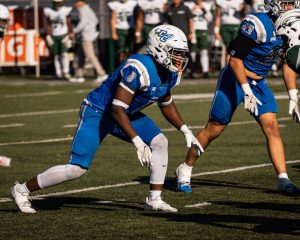It’s Like Wearing All Black At The Beach And Loving It
April 2, 2019
What do you get when you intertwine surf music with dubstep, hip-hop, punk, folk and lyrics about pain, despair and death? Beach goth.
The only question is whether it is more beach or goth.
This weird conversion of styles erupted with the formation of the founding band The Growlers.
In 2006, Brooks Nielsen and Matt Taylor from Dana Point, California formulated a plan to amp up their coolness at parties and with girls by creating a “shitty” garage band. To put it bluntly, they were terrible. Taylor rocked out minus his knowledge of the inner workings — and outer, apparently — of a guitar but that did not stop the duo from recruiting their friends, Brian Stewart jamming on drums and Clark Davison mashing on keys.
Their road to fame began in a utility warehouse owned by the singer Neilson’s dad. They practiced a depressing mishmash of Grateful Dead and 70’s punk covers, but something seemed missing from their collaboration.
The group shuffled around Orange County, living together in various cities trying to get a hold of their music. The atmosphere they grew up in was then channeled through their musical evolution. The sun-baked beach lifestyle transitioned their music to a more Doors-y surf-rock sound with burbling reverb and shiny keyboard beats.
Obsessed with self-expression and flaunting all their weirdness, the foursome played shows dressed as a pack of thrift-store hobos to crowds of swaying South County hipsters.
In 2012, The Growlers, along with various sponsors, began hosting the annual Beach Goth music festival. Every year in late October, Beach Goth is held in Santa Ana at The Observatory showcasing bands like Shannon and the Clams, FIDLAR, Wu-Tang Clan and Gucci Mane.
The unorthodox setlist stems from the expanding sphere that makes up the rebellious genre.
Beach Goth 2018 has changed its venue and will be hosted at the Los Angeles State Historic Park. This year it will only be one day because the festival is going on tour to a handful of cities.
Beach goth sounds like a rush of waves splashing and hitting the black hot pavement. The two should not belong together but somehow it creates something that sizzles the mind.
Nielsen’s voice, wise and weathered beyond his years, found its stride on songs such as “Tijuana” and “Sea Lion Goth Blues” — hypnotic, sorrowful and comforting all at once.
Beach goth can be categorized by distinctive candy-coated guitar licks, power-chords, simple drums and easy-going lyrics about heartbreak and the perfect wave.
In a similar fashion as the surf rock generation of the ’60s, beach goth flips this subgenre of a subgenre on its head. Morose lyrics, beachy voice and sound effects marry to create that original sound that transports you to driving down the boardwalk after a hard breakup.
MTV labeled beach goth as a lo-fi fusion of surf, garage rock and punk. Just think The Beach Boys calming beats laid over Joy Division’s lyrics.
The surfer culture amplified by The Beach Boys-inspired beach goth bands to utilize the surf instrumental. This tonal aesthetic is characterized by reverb-drenched electric guitars evoking the calming sounds of crashing waves.
Because of the stark lyrics and surfer vibe music, this band coined the term beach goth. Many debate that this band is in a genre all themselves but many bands were still inspired by the contrasting colors of this genre and carried on the legacy.
Each band embodies beach goth, despite sounding slightly different, because this genre is about the melting of surf sounds and rock ballad lyrics. The most important aspect of beach goth is to stay authentic to oneself by incorporating each artist’s unique background.



